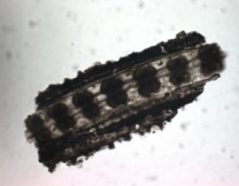Some Dinos Dined on Grass
Evidence taken from fossilized dinosaur poop shows that some of these reptiles ate grass.
By Emily Sohn
When dinosaur poop is preserved, it’s like a time capsule. The fossilized lumps contain clues about what the reptiles were eating long ago.
Recent analyses of fossilized dino droppings unearthed in India have turned up at least five types of grasses. The discovery is thrilling to paleontologists because it’s the first evidence that some dinosaurs actually ate grass. The remains also suggest that grass had evolved into different types much earlier than scientists had thought.
 |
|
This glassy fragment (about 100 micrometers long) was extracted from fossilized dinosaur dung unearthed in India. Its presence shows that the reptiles dined on grass. |
| © Science |
Titanosaurs probably produced the fossilized poop pellets 65 million years ago. Each piece of fossilized dung, called a coprolite, was shaped like a sphere and measured up to 10 centimeters (4 inches) across.
When the researchers looked closely at the coprolites, they were able to identify tiny fragments of glass called phytoliths. These little bits of silica form inside the cells of many plants, and they are especially common in grasses.
Each type of grass produces its own uniquely shaped phytolith. So, by analyzing phytoliths left behind in the dino excrement, the scientists were able to identify a variety of grasses that had passed through the digestive tracts of the animals. They also found evidence of other plants, including palm trees, conifers, and cycads.
Until now, the earliest known fossils of grass leaves and stems dated back just 56 million years. The new find pushes the date when grasses were flourishing back at least 9 million years, probably more.
The research could “completely revise what we’ve thought about the origin of grasses,” says Elizabeth A. Kellogg. She’s an evolutionary biologist at the University of Missouri-St. Louis. “This isn’t that much older than the oldest previous grass fossils, but to find such diversity at that time is surprising.”
Other evidence suggests grasses could have first appeared as far back as 80 million years ago.
Knowing that grasses arose so early might help explain a long-standing animal mystery. Just before the dinosaurs died out about 65 million years ago, mammals called gondwanatheres appeared on Earth.
Gondwanatheres were as big as groundhogs with long, flat teeth. Their teeth were similar to those of horses and other modern grass-eaters. Scientists have been puzzling about what these animals ate. Now they know that it might have been grass.—E. Sohn
Going Deeper:
Perkins, Sid. 2005. Ancient grazers: Find adds grass to dinosaur menu. Science News 168(Nov. 19):323. Available at http://www.sciencenews.org/articles/20051119/fob1.asp .







